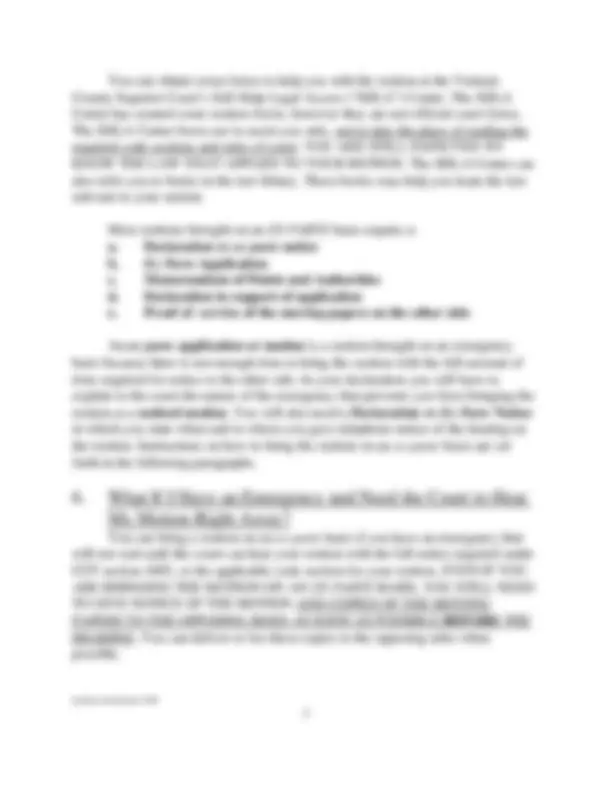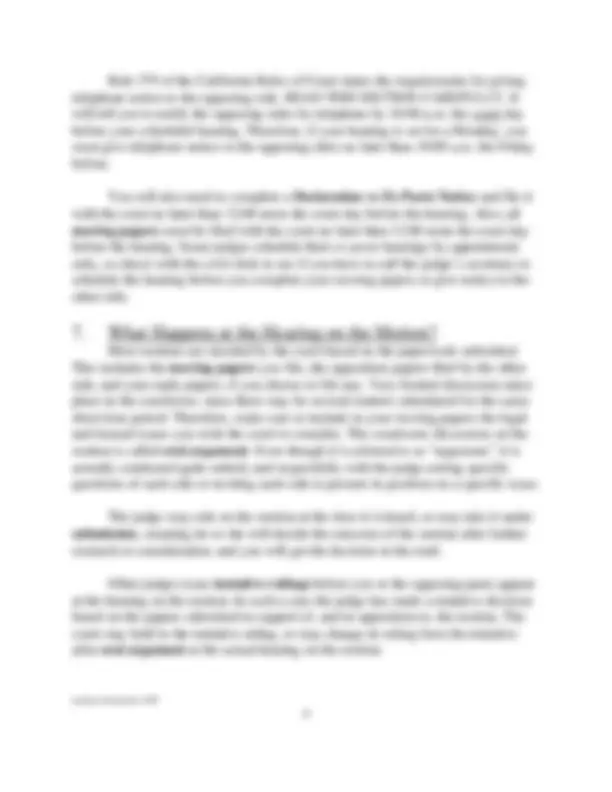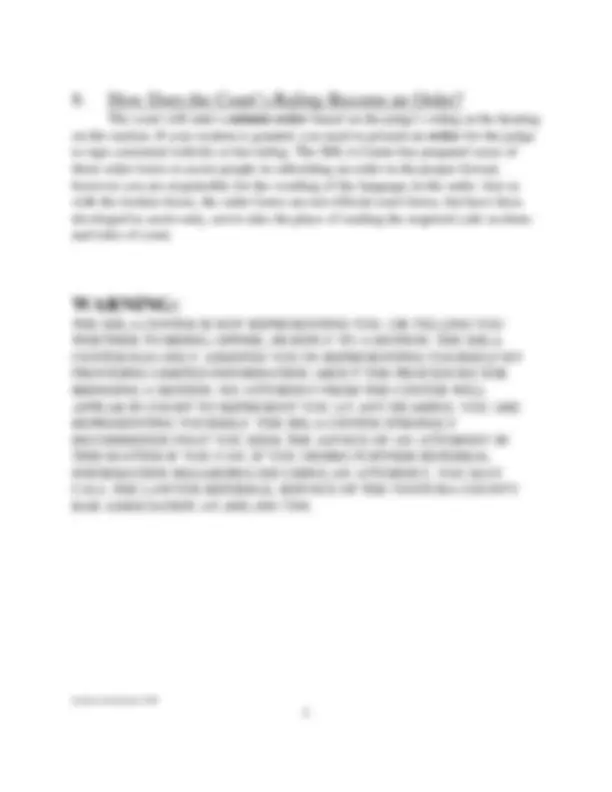





Study with the several resources on Docsity

Earn points by helping other students or get them with a premium plan


Prepare for your exams
Study with the several resources on Docsity

Earn points to download
Earn points by helping other students or get them with a premium plan
Community
Ask the community for help and clear up your study doubts
Discover the best universities in your country according to Docsity users
Free resources
Download our free guides on studying techniques, anxiety management strategies, and thesis advice from Docsity tutors
Instructions on how to file and serve a motion in California courts. It covers the definition of a motion, the requirements for giving notice to opposing parties, the process for getting a court date, the filing fee, and what to include in the motion. It also provides information on bringing a motion on an ex parte basis in case of an emergency.
What you will learn
Typology: Study notes
1 / 5

This page cannot be seen from the preview
Don't miss anything!




motion instructions 2/
A motion is the method used to speak to the judge about a matter in your case. For example, a motion may be brought to ask the court to set aside a default or vacate a default judgment , or it may be brought to ask the court to order a judgment to be paid in installments.
Due Process requires that the court only act when ALL sides in the case have had an opportunity to be heard. Therefore, before the court can hear or consider your motion you MUST:
A. GIVE PROPER NOTICE OF THE MOTION TO ALL OPPOSING SIDES. B. GIVE A COPY OF THE MOVING PAPERS (the papers you file with the court for the motion) TO ALL OPPOSING SIDES.
Code of Civil Procedure (“CCP”) section 1005 states the amount of time required to give notice of most motions. The moving papers must be personally given to each opposing side at least 21 days before the hearing on the motion, OR mailed to each opposing side at least 26 days before the hearing on the motion.
If the papers are personally given to the opposing side it is called personal service. Personal service can only be carried out by an adult (18 years or older) who is NOT a party to the case. That means that the person is neither a plaintiff nor a defendant in the case. The person who personally serves the papers must sign a proof of service. The sheriff’s department or a licensed process server can also serve legal papers. They normally charge a fee for their service.
If the papers are mailed to the opposing side it is called service by mail. Service by mail is only permitted once the party being served has appeared in the case. This means that the party being served has filed its first pleading in the court, whether that pleading be a complaint, petition, answer or other response. Service by mail can only be carried out by an adult (18 years or older) who is not a party to the case. The person who mails the papers must sign a certificate of service by mail.
motion instructions 2/
The signed proof of service or certificate of service by mail is attached to the back of the motion and filed with the court at the time the motion is filed. WARNING: SOME MOTIONS HAVE A DIFFERENT TIME PERIOD. YOU WILL NEED TO READ THE CCP SECTION THAT APPLIES TO THE TYPE OF MOTION YOU ARE BRINGING TO SEE IF IT HAS A DIFFERENT NOTICE REQUIREMENT.
BEFORE you can complete your moving papers, or have them served and filed, you need to get a hearing date assigned by the court. Either go to a civil window in room 210 of the Ventura Hall of Justice, or the clerk’s office in the East County Courthouse, or call the Ventura court at (805) 662-6620 and ask for a civil clerk. Tell the clerk what type of motion you are bringing, and when you want to have it set. Make sure you choose a date that is far enough away that you can give the other sides the required notice of the hearing. If there is not enough time for you to have the motion heard after giving the required notice, you may have to bring a motion to shorten time to have your other motion heard, or bring the motion on an ex parte , or emergency basis. (See paragraph 6 below for instructions on how to bring a motion ex parte .)
Yes. Most motions cost $23.00 to file. Certain types of motions, such as a Motion for Summary Judgment cost more. When you call the clerk to get a hearing date and time assigned you can ask what the filing fee is. If you are below the federal poverty line and have already applied for, and received a fee waiver in your case, you can complete the forms for an additional fee waiver, which are available in the clerk’s office or in the Self-Help Legal Access Center.
Most NOTICED motions require a: a. Notice of motion b. Memorandum of points and authorities c. Declaration d. Proof of Personal Service, or Certificate of Service by Mail
motion instructions 2/
Rule 379 of the California Rules of Court states the requirements for giving telephone notice to the opposing side. READ THIS SECTION CAREFULLY. It will tell you to notify the opposing sides by telephone by 10:00 a.m. the court day before your scheduled hearing. Therefore, if your hearing is set for a Monday, you must give telephone notice to the opposing sides no later than 10:00 a.m. the Friday before.
You will also need to complete a Declaration re Ex Parte Notice and file it with the court no later than 12:00 noon the court day before the hearing. Also, all moving papers must be filed with the court no later than 12:00 noon the court day before the hearing. Some judges schedule their ex parte hearings by appointment only, so check with the civil clerk to see if you have to call the judge’s secretary to schedule the hearing before you complete your moving papers or give notice to the other side.
Most motions are decided by the court based on the paperwork submitted. This includes the moving papers you file, the opposition papers filed by the other side, and your reply papers, if you choose to file any. Very limited discussion takes place in the courtroom, since there may be several matters calendared for the same short time period. Therefore, make sure to include in your moving papers the legal and factual issues you wish the court to consider. The courtroom discussion on the motion is called oral argument. Even though it is referred to as “argument,” it is actually conducted quite orderly and respectfully with the judge asking specific questions of each side or inviting each side to present its position on a specific issue.
The judge may rule on the motion at the time it is heard, or may take it under submission , meaning he or she will decide the outcome of the motion after further research or consideration, and you will get the decision in the mail.
Often judges issue tentative rulings before you or the opposing party appear at the hearing on the motion. In such a case the judge has made a tentative decision based on the papers submitted in support of, and in opposition to, the motion. The court may hold to the tentative ruling, or may change its ruling from the tentative after oral argument at the actual hearing on the motion.
motion instructions 2/
The court will enter a minute order based on the judge’s ruling at the hearing on the motion. If your motion is granted, you need to present an order for the judge to sign consistent with his or her ruling. The SHLA Center has prepared some of these order forms to assist people in submitting an order in the proper format, however you are responsible for the wording of the language in the order. Just as with the motion forms, the order forms are not official court forms, but have been developed to assist only, not to take the place of reading the required code sections and rules of court.